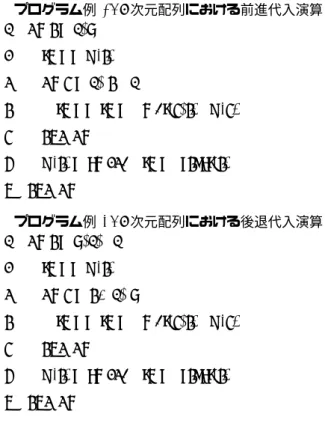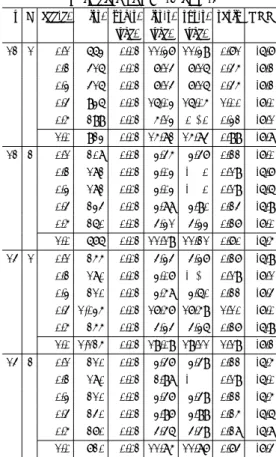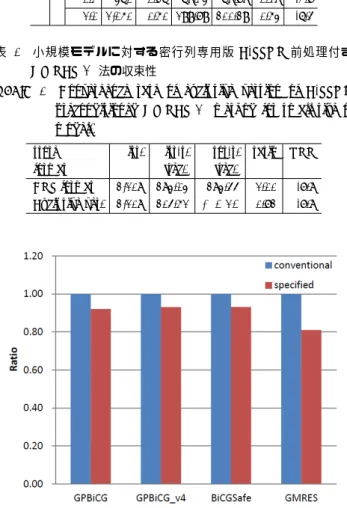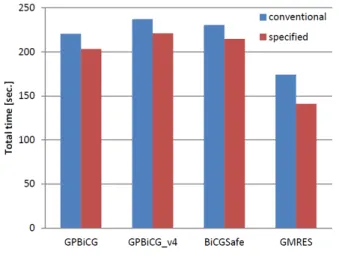密行列専用のプレコンディショニングつき
反復法の性能評価
岩里 洸介
1
藤野 清次
2
高橋 康人
3
概要:反復法の行列ベクトル積の計算において,疎行列の非零要素のみを格納し,間接参照によりその計
算を行うことが多い.このような
CRS
形式は,必要メモリ量が少なくかつ計算量も必要最少限で抑えら
れることから,疎行列向き格納法の一つであるとされる.一方,密行列に対しては,ごく自然な発想とし
て,全ての要素を格納する
2
次元配列を使用すれば,直接参照による計算時間の短縮が図れる可能性があ
る.本論文では,密行列専用版として直接参照を用いる反復法を実装し,密行列専用版反復法がどの程度
高速化が図れるかを調べることにする.
キーワード:密行列,反復法,
CRS
形式
Performance evaluation of exclusive version of
preconditioned iterative method for dense matrix
Abstract: As well known, only nonzero entries of a sparse matrix are stored in memory in CRS format. In
this case, nonzero entries are refered using indirect access, because it requires a small amount of memory
and short time of computation. CRS format, however, is inefficient in case of dense matrix because direct
access can be done using two-dimensional array. In this article, we implement an exclusive version of iterative
methods with two-dimensional array for dense matrix. Through numerical experiments, we examine speedup
of computation time of the proposed version.
Keywords: Dense matrix, Iterative method, CRS format
1.
はじめに
連立一次方程式
Ax = b
を解くことを考える.ここで,
A
は非対称の係数行列,
x
は解ベクトル,
b
は右辺項ベ
クトルである.係数行列
A
が疎であるとき,行列要素は
CRS(Compressed Row Storage)
方式などを用いて非零要
素のみ格納される.このような手法は間接参照を用いて非
零要素のみ計算するため,要求されるメモリ量や計算量が
抑えられ,疎行列に対して効率がよいとされる
[3]
.一方,
密行列に対しては間接参照の回数が増加するため,効率が
良いとは限らない.自然な考えとして,密行列に対しては
1 九州大学大学院システム情報科学府Graduate School of Information Science and Electrical
En-gineering, Kyushu University
2 九州大学情報基盤研究開発センター
Research Institute for Information Technology, Kyushu
Uni-versity
3 同志社大学理工学部
Faculty of Science and Engineering, Doshisha University
全ての要素を
2
次元配列に格納し,直接参照を用いて計算
する方法が挙げられる
[3]
.
前処理において,係数行列が密行列である場合,行列ベ
クトル積の計算に要する計算量が増加する
[4]
.そのため,
行列ベクトル積
2
回分の計算量を必要とする
ILU(0)
前処
理ではなく行列ベクトル積
1
回分とスカラーベクトル積
2
回分の計算量が必要な
Eisenstat
版
SSOR
前処理
[11]
が密
行列に対して有効だと考えられる.
そこで,本論文では密行列専用版
(exclusive version)
の
解法として行列要素を全て
2
次元配列に格納し,直接参照
を用いて計算を行う反復法を実装した.さらに,数値実験
を通して,
Eisenstat
版
SSOR
前処理付きの従来版と密行
列専用版の解法を比較し,密行列専用版の解法の計算時間
における高速化の度合いを調査する.
本論文の構成は以下の通りである.第
2
節で,
Eisensatat
版
SSOR
前処理について述べる.第
3
節で,行列要素の格
納方法について記述し,前進後退代入における実装方法の
違いを示す.第
4
節で,密行列専用版反復法の高速化の度
合いを数値実験により調査し,第
5
節で,まとめを行う.
2.
Eisenstat
版 SSOR 前処理
密行列に対して有効な前処理を考える.前処理行列
M
を用いて
M
−1Ax = M
−1b
と変形させる.
ILU(0)
などの
前処理では,前処理を行うことにより行列ベクトル積の計
算
2
回分の計算量が必要となる.一方,
Eisenstat
版
SSOR
前処理
(
以下,
E-SSOR
前処理と表記
)[11]
で必要な計算量
は行列ベクトル積
1
回とスカラーベクトル積
2
回分であ
る.
E-SSOR
前処理は
ILU(0)
前処理よりも計算量が少な
いため,密行列に対して有効であると考えられる
[7]
.した
がって,本論文では
E-SSOR
前処理を適用する.
2.1
SSOR
前処理
まず,
SSOR
前処理
[2]
について述べる.
SSOR
前処理
では,係数行列を
A = L + D + U
と分離して得られる行
列を用いて,前処理行列
K
を
K = (L + D/ω)(D/ω)
−1(U + D/ω)
(1)
とする.ここで,
ω
は緩和係数を意味する.両側前処理後
の係数行列を
A
˜
,解ベクトルを
x
˜
,右辺項を
b
˜
とすると,
˜
A = (L + D/ω)
−1A(U + D/ω)
−1(D/ω),
(2)
˜
x = (D/ω)
−1(U + D/ω)x,
(3)
˜
b = (L + D/ω)
−1b
(4)
で あ る .ま た ,反 復
k
回 目 に お け る 前 処 理 後 の 残 差
r
k:= b
− Ax
kを
r
˜
kとすると,
˜
r
n= ˜
b
− ˜
A˜
x
n= (L + D/ω)
−1b
− (L + D/ω)
−1A
×
(U + D/ω)
−1(D/ω)(D/ω)
−1(U + D/ω)x
n= (L + D/ω)(b
− Ax
n)
= (L + D/ω)
−1r
n(5)
と表される.
2.2
Eisenstat trick
SSOR
前処理は
Eisenstat trick
と呼ばれる手法を用いて
実装することで計算量を削減できる
[9]
.式
(2)
を
˜
A = ((U + D/ω)
−1+(L + D/ω)
−1(I + (1
− 2/ω)D(U + D/ω)
−1))(D/ω)
(6)
と式変形し,行列ベクトル積
Av
˜
を以下の手順で計算す
る
[5][8]
.
1.
y = (U + D/ω)
−1(D/ω)v,
2.
z = (D/ω)v + (1
− 2/ω)Dy,
3.
w = (L + D/ω)
−1z,
4.
Av = y + w.
˜
3.
行列要素の格納方法と前進後退代入演算
3.1
従来の格納方法と前進後退代入演算
非 対 称 疎 行 列 の 行 列 要 素 の 格 納 方 法 と し て
CRS(Compressed Row Storage)
方式
[3]
が用いられる.
プログラム例
1
に
CRS
方式における前進代入演算のプロ
グラム例を示す.ここで,
n
は次元数,
pivot
は各行の対
角項の逆数を取ったものである.
lval
は下三角行列
L
の
非零要素の配列,
lrowptr
は下三角行列
L
のポインタ配
列,
lcolind
は下三角行列
L
のインデックス配列である.
omega
は加速係数である.
w
はベクトルの要素を格納した
配列である.
プログラム例
1: CRS
方式における前進代入演算
1. do i = 1, n
2.
tmp = w(i)
3.
do j = lrowptr(i), lrowptr(i + 1)
− 1
4.
tmp = tmp
− lval(j) ∗ w(lcolind(j))
5.
end do
6.
w(i) = omega
∗ tmp ∗ pivot(i)
7. end do
プログラム例
2
に
CRS
方式を使用した場合の後退代入演算
のプログラム例を示す.
uval
は上三角行列
U
の非零要素
の配列,
urowptr
は上三角行列
U
のポインタ配列,
ucolind
は上三角行列
U
のインデックス配列である.
プログラム例
2: CRS
方式における後退代入演算
1. do i = n, 1,
−1
2.
tmp = w(i)
3.
do j = urowptr(i), urowptr(i + 1)
− 1
4.
tmp = tmp
− uval(j) ∗ w(ucolind(j))
5.
end do
6.
u(i) = omega
∗ tmp ∗ pivot(i)
7. end do
プログラム例
1
,同例
2
のように,密行列を
CRS
方式で格
納する場合,
4
行目の
w(ucolind(j))
において間接参照が
行われる.まず,
ucolind(j)
で配列
w
の番地を参照してか
ら,
w
に格納されている値を参照する.
w
の値を求めるた
めに
2
個の配列を参照するため,計算時間が長くなる.
3.2
密行列専用の格納方法と前進後退代入演算
密行列用に行列要素を
2
次元配列で格納する
[6]
.
2
次元
配列では全ての行列要素を格納する.プログラム例
3
,同
例
4
に
2
次元配列における前進後退代入のプログラム例を
示す
[3]
.
mat
は行列要素を格納した
2
次元配列である.
プログラム例
3: 2
次元配列における前進代入演算
1. do i = 1, n
2.
tmp = w(i)
3.
do j = 1, i
− 1
4.
tmp = tmp
− mat(j, i) ∗ w(j)
5.
end do
6.
w(i) = omega
∗ tmp ∗ pivot(i)
7. end do
プログラム例
4: 2
次元配列における後退代入演算
1. do i = n, 1,
−1
2.
tmp = w(i)
3.
do j = i + 1, n
4.
tmp = tmp
− mat(j, i) ∗ w(j)
5.
end do
6.
w(i) = omega
∗ tmp ∗ pivot(i)
7. end do
プログラム例
3
,同例
4
のように,行列要素を
2
次元配列
で格納した場合,
4
行目の配列
w
の値を直接参照で求めら
れるため,密行列に対して反復法の高速化が期待できるが,
どの程度改善できるかを知りたい.
4.
数値実験
4.1
電磁界解析で現れたテスト行列
同志社大学理工学部 藤原・高橋研究室より提供された
電磁界解析モデルのテスト行列に対する密行列専用版反
復法の収束性を調査する.使用した行列は
2
個で,共に
密行列である.行列
boxshield (
次元数:
4,902)
は
2
個の
コイルに挟まれた箱の解析モデル,行列
problem13 (
次元
数:
16,800)
は
TEAM (Testing Electromagnetic Analysis
Method) Workshop
により公開されている検証用の解析モ
デルである.図
1
に行列
boxshield
,
図
2
に行列
problem13
の解析モデルとメッシュ図と磁束密度分布を示す.ここ
で,メッシュ図は対称性から図
1
では全体の
1/8
,図
2
で
は
1/4
のみ表示した.
4.1.1
計算機環境と計算条件
計算機は
Dell PowerEdge R210
(戦略名:
Sandy Bridge,
CPU
:
Intel Xeon E3-1220
,クロック周波数:
3.1GHz
,メ
モリ:
8.2Gbytes
,
L3
キャッシュメモリ:
8.2Mbytes, OS
:
Red Hat Linux Enterprise
)を使用した.プログラムは
For-tran90
を用いて実装し,コンパイラは
Intel Fortran
Com-piler ver.12.1.3
を使用した.最適化オプションは
“-O3”
を
使用した.右辺項は物理的条件から得られる値を用いた.収
束判定条件は相対残差の
2
ノルム:
||r
k+1||2/
||r0||2
≤ 10
−8とした.初期近似解
x
0はすべて
0
とした.前処理は対
角スケーリングと
E-SSOR
前処理を使用した.最大反
図
1
行列boxshield
の解析モデルとメッシュ図と磁束密度分布Fig. 1
Analytic model, mesh and distribution of density
in case of matrix boxshield.
図
2
行列problem13
の解析モデルとメッシュ図と磁束密度分布Fig. 2
Analytic model, mesh and distribution of density
in case of matrix problem13.
復回数は
10000
回とした.解法は
GPBiCG
法
[14]
,
GP-BiCG variant4
法
(
以下,
GPBiCG v4
と表記
)[1]
,
BiCGSafe
法
[10]
,
GMRES
法
[12]
,
GBiCGSTAB(s,L)[13]
法の
5
種
類を使用した.
4.1.2
実験結果
表
1
,表
2
に行列
boxshield
に対する
E-SSOR
前処理つ
き反復法の収束性を示す.表中の
GMRES
法のリスタート
係数は
500
,加速係数は
0.1
から
1.0
まで
0.1
刻みで実験を
行った.ここで,
0.6
から
0.9
までの実験結果については全
ての解法で最短で収束するケースが無かったので,省略し
た.
GBiCGStab(s,L)
法では
s
を
4,8,10,12,14
,
L
を
1,2
と
変化させた.
TRR
は
True Relative Residual
の略で常用
対数
log
10(
||b − Ax
k+1||2
/
||b − Ax0||2
)
の値を意味する.
“acc-c.”
は
accelerated coefficient
の略で加速係数を示す.
また,
“pre-t.”
は前処理にかかった時間,
“itr-t.”
は反復計
表
1
行列boxshield
に対するE-SSOR
前処理つき反復法の収束性Table 1
Convergence rate of four E-SSOR preconditioned
it-erative methods for matrix boxshield.
method acc-c. itr. pre-t. itr-t. tot-t. ratio TRR [sec.] [sec.] [sec.]
GPBiCG 0.1 125 0.02 4.20 4.22 0.26 -8.0 0.2 180 0.02 6.03 6.05 0.38 -8.0 0.3 150 0.02 5.02 5.05 0.31 -7.6 0.4 205 0.02 6.85 6.87 0.43 -8.5 0.5 230 0.02 7.68 7.70 0.48 -8.2 1.0 480 0.02 16.01 16.04 1.00 -8.0 GPBiCG v4 0.1 105 0.02 3.54 3.56 0.22 -8.5 0.2 215 0.02 7.19 7.21 0.45 -8.5 0.3 260 0.02 8.69 8.71 0.54 -8.1 0.4 170 0.02 5.69 5.71 0.36 -8.1 0.5 195 0.02 6.54 6.56 0.41 -8.3 1.0 620 0.02 20.68 20.71 1.29 -8.4 BiCGSafe 0.1 235 0.02 7.86 7.88 0.49 -8.7 0.2 225 0.02 7.52 7.54 0.47 -8.0 0.3 230 0.02 7.69 7.71 0.48 -8.2 0.4 170 0.02 5.69 5.71 0.36 -8.7 0.5 185 0.02 6.18 6.21 0.39 -8.1 1.0 720 0.02 23.99 24.01 1.50 -8.1 GMRES 0.1 142 0.02 2.34 2.37 0.15 -8.2 0.2 137 0.02 2.25 2.27 0.14 -8.2 0.3 145 0.02 2.39 2.41 0.15 -8.1 0.4 156 0.02 2.58 2.60 0.16 -8.0 0.5 174 0.02 2.87 2.89 0.18 -7.9 1.0 390 0.02 6.61 6.63 0.41 -7.5
間である.
ratio
は
GPBiCG
法の加速係数
1.0
における合
計時間を
1
としたときの他の解法の合計時間の比である.
表
1,
表
2
より以下のことがわかる.
( 1 ) GMRES
法で加速係数が
0.2
のとき,合計時間は
2.27
秒で最も速く収束した.
( 2 )
次いで,
GPBiCGStab
法が
(s,L)=(10,2)
で加速係数
0.2
のとき
2.97
秒で収束した.
表
3,
表
4
に行列
problem13
に対する
E-SSOR
前処理
つき反復法の収束性を示す.
表
3
,表
4
より以下のことがわかる.
( 1 ) GMRES
法で加速係数が
0.3
のとき,合計時間は
43.02
秒で最も速く収束した.
( 2 )
次いで,
BiCGSafe
法が加速係数
0.2
のとき
88.83
秒で
収束した.
4.2
積分方程式法によるテスト行列の場合
積分法試験法による解析で得られた解析モデルの行列
2
個で,次元数
11,308
,非零要素数
127,870,864(
小規模モデ
ル
)
と次元数
20,756
,非零要素数
430,811,536(
中規模モデ
ル
)
でどちらも密行列である.
4.2.1
計算機環境と計算条件
計算はすべて倍精度浮動小数点演算で行った.小規模モ
デルに対しては,計算機は
Dell PowerEdge R210
(戦略
名:
Sandy Bridge, CPU
:
Intel Xeon E3-1220
,クロック
表
2
行列boxshield
に対するE-SSOR
前処理つきGBiCGStab(s,L)
法の収束性Table 2
Convergence rate of E-SSOR preconditioned
GBiCGStab(s,L) method for matrix boxshield.
(a) in case of s = 4
∼ 10
s L acc-c. itr. pre-t. itr-t. tot-t. ratio TRR [sec.] [sec.] [sec.]
4 1 0.1 max 0.02 - - - 60.9 0.2 225 0.02 4.30 4.32 0.27 -8.1 0.3 3,010 0.02 57.42 57.44 3.58 -8.1 0.4 1,575 0.02 30.02 30.04 1.87 -8.0 0.5 510 0.02 9.74 9.76 0.61 -8.0 1.0 1,060 0.02 20.23 20.25 1.26 -7.2 4 2 0.1 190 0.02 3.33 3.36 0.21 -6.9 0.2 180 0.02 3.16 3.18 0.20 -7.8 0.3 210 0.02 3.68 3.71 0.23 -7.9 0.4 240 0.02 4.22 4.25 0.27 -7.9 0.5 260 0.02 4.56 4.58 0.29 -7.8 1.0 800 0.02 13.98 14.00 0.87 -8.1 8 1 0.1 792 0.02 14.04 14.06 0.88 -5.6 0.2 243 0.02 4.32 4.34 0.27 -7.1 0.3 1,719 0.02 30.44 30.46 1.90 -8.0 0.4 1,035 0.02 18.31 18.33 1.14 -7.5 0.5 720 0.02 12.76 12.79 0.80 -7.3 1.0 945 0.02 16.74 16.76 1.05 -7.1 8 2 0.1 198 0.02 3.35 3.37 0.21 -7.4 0.2 180 0.02 3.05 3.07 0.19 -7.0 0.3 198 0.02 3.35 3.37 0.21 -7.7 0.4 216 0.02 3.65 3.68 0.23 -7.1 0.5 270 0.02 4.56 4.58 0.29 -7.2 1.0 684 0.02 11.52 11.54 0.72 -7.4 10 1 0.1 209 0.02 3.65 3.68 0.23 -7.0 0.2 297 0.02 5.19 5.21 0.33 -7.0 0.3 187 0.02 3.28 3.30 0.21 -7.5 0.4 528 0.02 9.20 9.22 0.58 -7.4 0.5 1,507 0.02 26.21 26.23 1.64 -7.5 1.0 1,111 0.02 19.34 19.36 1.21 -7.7 10 2 0.1 198 0.02 3.31 3.33 0.21 -6.8 0.2 176 0.02 2.95 2.97 0.19 -6.8 0.3 198 0.02 3.32 3.34 0.21 -6.7 0.4 220 0.02 3.69 3.71 0.23 -7.3 0.5 286 0.02 4.78 4.81 0.30 -6.6 1.0 682 0.02 11.39 11.41 0.71 -7.2
周波数:
3.1GHz
,メモリ:
8.2Gbytes
,
L3
キャッシュメモ
リ:
8.2Mbytes
,
OS
:
Red Hat Linux Enterprise
)を使用
した.プログラムは
Fortran90
を用いて実装し,コンパイ
ラは
Intel Fortran Compiler ver.12.1.3
を使用した.中規
模モデルに対しては,計算機は
CX400
(
CPU
:
Intel Xeon
E5-2690
,クロック周波数:
2.7GHz
,メモリ:
128Gbytes
,
キャッシュメモリ:
20Gbytes
,
OS
:
Red Hat Linux
Enter-prise
)を使用した.プログラムは
Fortran90
を用いて実装
し,コンパイラは
Fujitsu Fortran Compiler
を使用した.
最適化オプションは
“-O3”
を使用した.右辺項は物理的
条件から得られる値を用いた.収束判定条件は相対残差の
2
ノルム:
||r
k+1||2/
||r0||2
≤ 10
−8とした.初期近似解
x
0(b) in case of s = 12 and 14
s L acc-c. itr. pre-t. itr-t. tot-t. ratio TRR [sec.] [sec.] [sec.]
12 1 0.1 663 0.02 11.37 11.39 0.71 -6.7 0.2 416 0.02 7.14 7.16 0.45 -7.2 0.3 416 0.02 7.14 7.16 0.45 -7.2 0.4 936 0.02 16.03 16.05 1.00 -7.0 0.5 299 0.02 5.13 5.15 0.32 -7.1 1.0 923 0.02 15.82 15.84 0.99 -7.8 12 2 0.1 208 0.02 3.45 3.47 0.22 -7.0 0.2 182 0.02 3.03 3.05 0.19 -6.7 0.3 182 0.02 3.03 3.05 0.19 -6.6 0.4 234 0.02 3.88 3.90 0.24 -6.9 0.5 260 0.02 4.31 4.33 0.27 -7.0 1.0 676 0.02 11.19 11.21 0.70 -6.5 14 1 0.1 255 0.02 4.34 4.37 0.27 -6.9 0.2 180 0.02 3.07 3.10 0.19 -7.1 0.3 210 0.02 3.58 3.60 0.22 -7.4 0.4 1,035 0.02 17.57 17.59 1.10 -7.0 0.5 255 0.02 4.34 4.36 0.27 -6.9 1.0 1,125 0.02 19.09 19.11 1.19 -7.2 14 2 0.1 210 0.02 3.47 3.49 0.22 -6.5 0.2 180 0.02 2.98 3.00 0.19 -6.0 0.3 210 0.02 3.47 3.49 0.22 -6.5 0.4 240 0.02 3.97 3.99 0.25 -6.6 0.5 270 0.02 4.46 4.49 0.28 -6.8 1.0 720 0.02 11.85 11.87 0.74 -7.4 表
3
行列problem13
に対するE-SSOR
前処理つき反復法の収束性Table 3
Convergence rate of four E-SSOR preconditioned
it-erative methods for matrix problem13.
method acc-c. itr. pre-t. itr-t. tot-t. ratio TRR [sec.] [sec.] [sec.]
GPBiCG 0.1 330 1.49 128.73 130.22 0.35 -7.9 0.2 275 0.25 106.49 106.74 0.28 -6.5 0.3 385 0.33 149.55 149.87 0.40 -8.3 0.4 300 0.25 116.41 116.67 0.31 -8.2 0.5 320 0.25 124.10 124.35 0.33 -8.2 1.0 975 0.25 377.05 377.30 1.00 -8.0 GPBiCG v4 0.1 350 0.25 135.56 135.81 0.36 -8.0 0.2 295 0.26 114.52 114.77 0.30 -8.3 0.3 245 0.25 95.04 95.29 0.25 -8.1 0.4 265 0.25 102.86 103.12 0.27 -8.5 0.5 295 0.25 114.57 114.83 0.30 -8.3 1.0 675 0.26 262.53 262.79 0.70 -8.1 BiCGSafe 0.1 305 0.25 118.11 118.36 0.31 -8.4 0.2 230 0.25 88.58 88.83 0.24 -7.7 0.3 230 0.25 89.22 89.47 0.24 -8.4 0.4 250 0.25 97.90 98.15 0.26 -8.2 0.5 270 0.25 104.16 104.42 0.28 -8.3 1.0 915 0.25 359.08 359.33 0.95 -8.0 GMRES 0.1 229 0.25 43.32 43.57 0.12 -8.0 0.2 230 0.25 43.55 43.81 0.12 -8.0 0.3 229 0.25 42.76 43.02 0.11 -8.2 0.4 241 0.25 45.00 45.25 0.12 -8.1 0.5 258 0.25 48.25 48.50 0.13 -7.9 1.0 594 0.25 112.21 112.46 0.30 -7.6
前処理を使用した.最大反復回数は
10000
回とした.
表4
行列problem13
に対するE-SSOR
前処理つきGBiCGStab(s,L)
法の収束性Table 4
Convergence rate of E-SSOR preconditioned
GBiCGStab(s,L) method for matrix problem13.
(a) in case of s = 4
∼ 10
s L acc-c. itr. pre-t. itr-t. tot-t. ratio TRR [sec.] [sec.] [sec.]
4 1 0.1 max 0.320 - - - 31.6 0.2 max 0.683 - - - 46.2 0.3 1,125 0.697 249.11 249.80 0.66 -7.4 0.4 550 1.222 122.22 123.44 0.33 -7.6 0.5 790 0.440 174.94 175.38 0.46 -8.0 1.0 1,795 0.626 398.33 398.96 1.06 -7.9 4 2 0.1 350 0.356 71.03 71.39 0.19 -6.5 0.2 370 0.402 75.13 75.53 0.20 -7.5 0.3 390 0.605 80.49 81.10 0.21 -7.6 0.4 400 0.876 81.42 82.29 0.22 -6.8 0.5 470 0.663 95.54 96.20 0.25 -8.1 1.0 1,270 0.388 257.88 258.27 0.68 -7.1 8 1 0.1 max 0.967 - - - 16.3 0.2 468 0.644 96.14 96.78 0.26 -6.8 0.3 450 0.528 92.67 93.20 0.25 -6.7 0.4 378 1.554 78.16 79.71 0.21 -6.9 0.5 837 0.780 172.48 173.26 0.46 -7.1 1.0 1,260 0.386 258.63 259.01 0.69 -6.3 8 2 0.1 324 0.494 63.81 64.30 0.17 -5.6 0.2 324 0.411 64.08 64.49 0.17 -6.1 0.3 360 0.455 71.59 72.04 0.19 -5.9 0.4 324 0.405 63.50 63.90 0.17 -7.1 0.5 414 0.510 80.56 81.07 0.21 -6.7 1.0 1,152 0.413 225.67 226.08 0.60 -6.5 10 1 0.1 341 0.448 68.84 69.29 0.18 -6.6 0.2 528 0.521 106.53 107.05 0.28 -6.6 0.3 330 0.731 66.65 67.38 0.18 -6.6 0.4 440 0.337 88.89 89.23 0.24 -6.9 0.5 506 0.316 102.15 102.47 0.27 -6.7 1.0 1,507 0.476 303.83 304.31 0.81 -6.8 10 2 0.1 308 0.424 59.56 59.98 0.16 -5.4 0.2 330 0.635 63.97 64.60 0.17 -6.2 0.3 308 0.485 60.68 61.17 0.16 -6.0 0.4 352 0.455 69.69 70.14 0.19 -6.4 0.5 396 0.323 76.36 76.68 0.20 -6.6 1.0 990 0.331 190.70 191.03 0.51 -6.7
4.2.2
実験結果
表
5
に小規模モデルに対する密行列専用版
E-SSOR
前
処理付き
GMRES(k)
法の収束性を示す.リスタート係数
は
2200
,加速係数は
0.7
で実験を行った.
表
5
より密行列専用版
E-SSOR
前処理
GMRES(k)
法が
従来法より
18%
計算時間が短縮された
.
表
6
に中規模モデルに対する密行列専用版
E-SSOR
前
処理付き反復法の収束性を示す.ここで,加速係数は
0.6
から
1.0
まで
0.1
刻みで変化させた.表中の
ratio
は従来版
の合計時間を
1
とした時の専用版の合計時間の比である.
図
3
に各解法の従来版と専用版の合計時間比を示す.
図
4
に各解法の従来版と専用版の合計時間を比較した図
を示す.
(b) in case of s=12 and 14
s L acc-c. itr. pre-t. itr-t. tot-t. ratio TRR [sec.] [sec.] [sec.]
12 1 0.1 481 0.53 95.58 96.10 0.25 -6.3 0.2 299 0.79 59.59 60.38 0.16 -6.0 0.3 312 0.82 62.16 62.98 0.17 -6.5 0.4 351 0.55 69.79 70.34 0.19 -6.4 0.5 559 0.58 111.10 111.68 0.30 -7.3 1.0 1,625 0.41 321.51 321.91 0.85 -7.2 12 2 0.1 286 0.46 54.88 55.34 0.15 -5.2 0.2 286 0.34 54.90 55.24 0.15 -5.4 0.3 338 0.56 64.80 65.36 0.17 -6.1 0.4 338 0.51 64.82 65.33 0.17 -6.3 0.5 364 0.53 70.24 70.77 0.19 -6.3 1.0 1,014 0.37 194.14 194.51 0.52 -6.5 14 1 0.1 330 0.50 65.02 65.52 0.17 -6.9 0.2 330 0.45 65.14 65.59 0.17 -6.3 0.3 315 0.48 62.15 62.62 0.17 -6.5 0.4 375 0.26 75.18 75.44 0.20 -6.7 0.5 585 0.26 114.77 115.03 0.30 -5.0 1.0 1,395 0.26 273.53 273.79 0.73 -6.5 14 2 0.1 300 0.57 57.29 57.86 0.15 -5.5 0.2 300 0.34 57.19 57.53 0.15 -5.0 0.3 330 0.26 62.79 63.04 0.17 -4.8 0.4 360 0.26 68.52 68.77 0.18 -4.7 0.5 360 0.26 68.53 68.78 0.18 -5.7 1.0 1,050 0.50 199.79 200.29 0.53 -6.4 表
5
小規模モデルに対する密行列専用版E-SSOR
前処理付きGMRES(k)
法の収束性Table 5
Convergence rate of exclusive version of E-SSOR
preconditioned GMRES(k) method for small size of
model.
store itr. itr-t. tot-t. ratio TRR format [sec.] [sec.]
CRS format 2,108 283.03 283.44 1.00 -7.8 Exclusive ver. 2,108 204.51 204.64 0.72 -7.8
図
3
各解法の従来版と専用版の合計時間比の比較Fig. 3
Comparison of the conventional CRS version and
exclu-sive version of iterative methods in view of the ratio of
total computation time.
表
6
中規模モデルに対する密行列専用版E-SSOR
前処理付き反復 法の収束性Table 6
Convergence rate of exclusive version of four E-SSOR
preconditioned iterative methods for middle size of
model.
method acc-c. itr. pre-t. itr-t. tot-t. ratio TRR [sec.] [sec.] [sec.]
GPBiCG 0.6 180 1.82 225.14 226.96 1.00 -8.2 (CRS) 0.7 175 1.81 218.87 220.68 1.00 -8.0 0.8 175 1.78 218.96 220.74 1.00 -8.1 0.9 195 1.81 243.91 245.72 1.00 -8.7 1.0 180 1.81 225.02 226.83 1.00 -8.3 GPBiCG 0.6 180 0.43 208.57 209.01 0.92 -8.2 (exclu.) 0.7 175 0.43 202.76 203.20 0.92 -8.0 0.8 175 0.44 202.77 203.20 0.92 -8.1 0.9 195 0.44 225.83 226.28 0.92 -8.7 1.0 180 0.44 208.54 208.97 0.92 -8.3 GPBiCG v4 0.6 180 1.81 223.19 224.99 1.00 -8.2 (CRS) 0.7 190 1.78 235.47 237.25 1.00 -8.0 0.8 185 1.79 229.26 231.05 1.00 -8.3 0.9 175 1.81 216.84 218.65 1.00 -8.1 1.0 185 1.81 229.44 231.25 1.00 -8.1 GPBiCG v4 0.6 180 0.44 209.07 209.51 0.93 -8.2 (exclu.) 0.7 190 0.43 220.61 221.05 0.93 -8.0 0.8 185 0.44 214.82 215.26 0.93 -8.3 0.9 175 0.43 203.39 203.82 0.93 -8.1 1.0 185 0.44 214.82 215.25 0.93 -8.1 BiCGSafe 0.6 180 1.81 222.59 224.41 1.00 -8.0 (CRS) 0.7 185 1.80 228.67 230.47 1.00 -8.2 0.8 175 1.79 216.31 218.10 1.00 -8.1 0.9 185 1.80 228.80 230.60 1.00 -8.2 1.0 195 1.81 241.01 242.82 1.00 -8.2 BiCGSafe 0.6 180 0.44 208.59 209.02 0.93 -8.0 (exclu.) 0.7 185 0.45 214.29 214.74 0.93 -8.2 0.8 175 0.44 202.76 203.20 0.93 -8.1 0.9 185 0.44 214.38 214.82 0.93 -8.2 1.0 195 0.44 225.97 226.40 0.93 -8.2 GMRES 0.6 261 2.84 177.50 180.33 1.00 -8.1 (CRS) 0.7 252 2.84 171.37 174.22 1.00 -8.0 0.8 257 2.83 174.32 177.16 1.00 -7.9 0.9 263 2.84 178.73 181.57 1.00 -7.9 1.0 278 2.84 188.58 191.41 1.00 -7.8 GMRES 0.6 261 0.44 145.78 146.22 0.81 -8.1 (exclu.) 0.7 252 0.44 140.66 141.11 0.81 -8.0 0.8 257 0.44 143.39 143.84 0.81 -7.9 0.9 263 0.44 146.70 147.14 0.81 -7.9 1.0 278 0.45 155.12 155.57 0.81 -7.8
表
6
,図
3
,図
4
より以下のことがわかる.
( 1 )
全ての解法で従来版よりも専用版のほうが計算速度が
向上した.
( 2 )
特に,
GMRES
法では専用版が従来版と比べて
19%
計
算時間が短縮された.
( 3 )
同様に,
GPBiCG
法では専用版が従来版より
7.9%
短
縮された
.
5.
まとめ
本論文では,密行列に対して行列要素を
2
次元配列で
図




